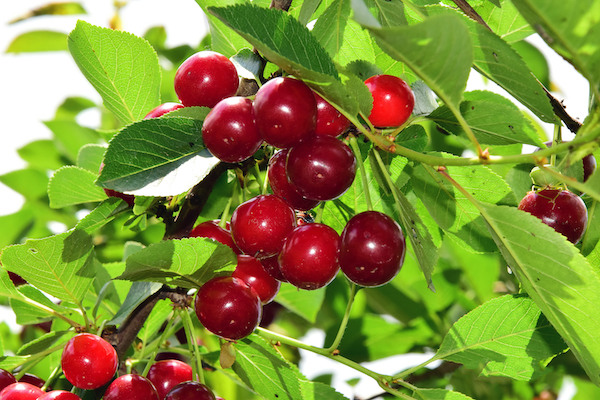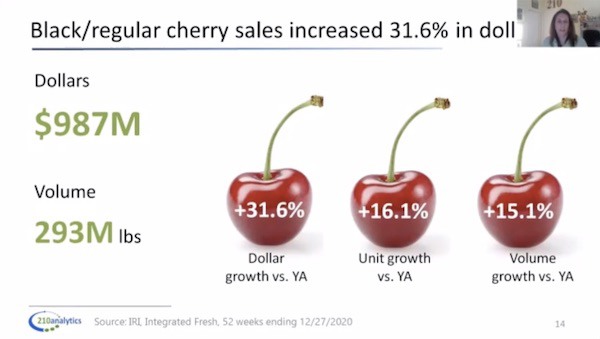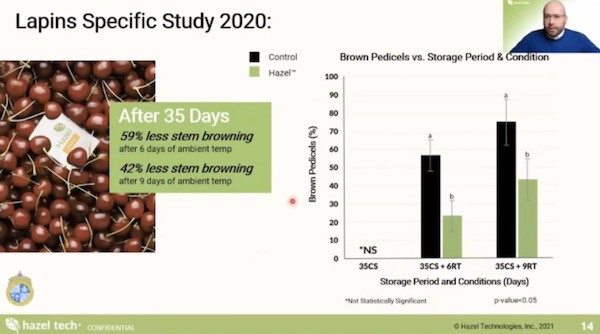On Friday, Hazel Technologies hosted the first annual Cherry Quality Summit. This one-hour event featured speakers who covered all aspects of the supply chain. Anne-Marie Roerink of 210 Analytics spoke on the performance of cherries at US retail, Dr. Yu Dong spoke on his research on cherry shelf-life extension, David Ortega of Orchard View Farms spoke about their experience using Hazel Technologies’ sachets for their cherries and finally Mario Cervantes of Hazel Technologies also discussed some research trials that have been done to test the technology’s efficacy on cherries.

Cherry opportunities at retail
2020 was a strong year for cherries, says Roerink. “In 2020, about 306 million pounds of cherries were sold at US retailers, and it is a $1.1 billion category. Last year, the cherry volumes sold were up by 15% and the dollars sold were up 32%. There are two main reasons for this big gap: there was inflation, and there were less promotions done at the retail level, meaning that the cherries were sold at higher, less discounted prices. The pounds of cherries sold on promotion were down about 10% compared with the average, which is part of what drove the dollar growth in 2020.”
Cherries provide a lot of opportunities to retailers for a few reasons. “Cherries are an excellent example of the main strength of fruit: people buy fruit with their eyes, and the cherry category is very visually attractive. They are also often an impulse buy. People often plan to buy apples or bananas at the store but don’t decide to buy cherries until they see them on display, meaning they are an incremental purchase. Finally, the cherries have a high dollar ring; the average price per volume for total produce is $1.75 per lb. but for cherries its $3.45 per lb., which makes them an exciting item for retailers to stock,” Roerink explains.

Roerink also discussed some approaches the cherry industry could take to help boost their sales even more this year. “Cherries have a short season compared to some other products that are on offer at retail year-round. This is something capitalize on: create a buzz around the season and make it something that consumers look forward to. Especially with the prominence of online grocery shopping nowadays, we have to work harder to make sure that the consumer is aware that the cherries are on offer, so make sure that this is something you’re promoting in many different places,” she says, adding: “In 2020 there were a few surprising growth categories in produce, one of which was oranges. The reason for their growth was their association with immunity and vitamin C. So, highlight the health benefits of the cherries and makes sure the consumer knows their nutritional value because that is what will draw them in even more.”
Keeping the cherries fresh
As Roerink pointed out, one of the selling points of cherries is their visual beauty in-stores. To ensure that the cherries stay beautiful and fresh for as long as possible, a shelf-life extension solution can be applied. Orchard View Farms, located in Dalles, Oregon, has been using Hazel in their operations since 2018. Ortega shares: “We ship our cherries domestically and across the globe. There is high demand for our cherries in Asia, Latin America, Europe and Canada. We started testing the product a few years ago and added it to all our export cartons. It is very easy to use on the production side and we’ve had a very positive experience with the product these past years. There is less dehydration in the cherry and in the stem itself, and the cherries maintained more firmness and showed reduced symptoms of decay. We’ve definitely seen a reduction in claims and are able to store and ship our fruit to far destinations with more confidence.”
In his research, Dr. Yu Dong tested the effectiveness of the technology developed by Hazel. “We found that the Hazel sachets helped to maintain firmness on late season varieties, specifically the Sweetheart variety responded really well to it. We also found reduced stem browning and reduced surface pitting. Finally, we found that the treated fruit had brighter colors,” he shares.

Cervantes also briefly discusses some trials done to examine Hazel’s effect on cherries. “In a study that looked at the Sweetheart variety, which was done by Universidad Católica in Chile, they found that after 35 days in cool storage and 6 days in ambient temperatures, there was 35% less stem browning on the cherries treated with Hazel and at 9 days in ambient temperatures there was 28% less stem browning. The results for a study on the Lapin variety were even higher: 59% less stem browning at 6 days in ambient temperature and 42% less stem browning at 9 days, both including 35 days in cold storage prior to the days in ambient temperature.”
“Using a shelf-life extending technology such as Hazel helps growers reduce adjustments at destination and have overall better arrivals. Retailers will be able to provide the optimum consumer experience by providing high-quality fresh fruit and have stronger merchandizing opportunities, which all results in an increased sales velocity,” Cervantes concludes.
 For more information:
For more information:
Jaime Kedrowski
Hazel Technologies
Tel: +1 (559) 321-2146
Email: jaime@hazeltechnologiesinc.com
www.hazeltechnologies.com
 Anne-Marie Roerink
Anne-Marie Roerink
210 Analytics LLC
Tel: +1 (210) 651-2719
Email: aroerink@210analytics.com
www.210analytics.com
